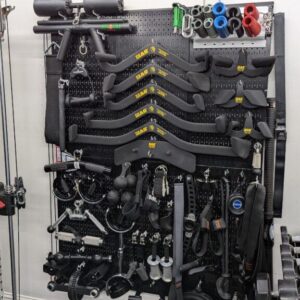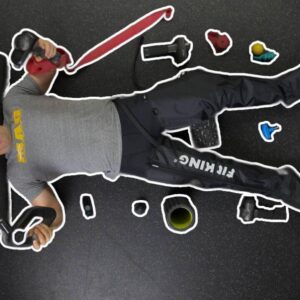Goal Setting For Powerlifters – Be A Better Lifter In 2025
Goal setting is the simple act of identifying where you are now and setting a target for where you want to be. If you don’t have goals, that is actually OK. If you work out because it is good for you, or you just enjoy it. If you eat healthy because your doctor said so, or you simply want to feel good and fit into your clothes better. Or maybe you are making consistent progress that you are happy with, or if you end your lifting life squatting 200 or 800 and it doesn’t matter, then you can probably skip this entire article.
You are, in fact, achieving your intended goals with your exercise program. Nicely done. Get in the gym, do your workouts, have some fun, eat like an adult, get your sleep, rinse and repeat.
However, if you are trying to accomplish something a little more extraordinary, whether it be setting some big PRs in your favorite lifts or looking shredded for beach season. If you want to squat, bench, deadlift, carry, clean, or even curl more weight than you are now, or you want to be faster, or stretchier, or whatever. If you are somewhere in your training today, and it isn’t where you want it to be in the future, then it might be time to invest a little effort into goal setting.
Table of Contents
Key Notes
If you are trying to accomplish something a little extraordinary, you need to be goal setting and monitoring those goals every year. Start Goal Setting Now!
Transparency Note
Some of the items and links in this article might be affiliate links, or might be linked to a Sponsor of the Garage Gym Competition. These links and sponsorships help fund the website, the competition itself, the newsletter, non-profit donations, and everything else we do FOR FREE here at the GGC. I like to be transparent so you know what is up. I appreciate the support if you choose to use the links.
My Background with Goal Setting For Powerlifters
I’ve been lifting since I got out of high school at least a few times a week. I wouldn’t count anything south of year 5 of my gym years as actual training, more just lifting weights and drinking the occasional protein shake. The first goals I ever set in the gym were things like “lose some fat and gain some muscle”. I really had no idea what goal setting was or how to formulate a proper goal, but I kind of instinctively knew that putting a stake in the ground meant I would be working towards something and be much more likely to achieve it.
This is a HUGE factor in goal setting. Even the weakest of goals set, puts you in the right direction because you now have a path to take. It also lets you reflect on what worked, and maybe what didn’t. If you missed your goal, maybe your training, or nutrition, or something else was out of whack. It can also let you add in interventions when you don’t hit your targets, before you waste even more time towards your goals.
I ran my companies Performance Management program for over 5 years, helping set annual goals, metrics, and analyzing success for close to 1600 employees. I did a LOT of reading, learning, and teaching on goal setting. I’m not saying I’m an expert, I didn’t write the metaphorical book on goal setting, but I’ve spent more than my fair share of time understanding how to write an end goal, break it down into obtainable pieces, and then put a plan in place.
That time spent on goal setting in the corporate world, translated to my gym life. Which is how I went from “lose some fat and gain some muscle” to “I’m going to deadlift 630lbs before I turn 40 years of age”.
If you don’t know where you are going, any road will get you there
If you have no direction, no guiding light, no goals, it is pretty easy to get lost in a world of simply showing up. Without a clear direction, we often do the same things over and over and over. We have nothing to tell us if we are moving towards our goal, or further away from it. Which means we have no measure if what we are doing is working, or not.
Not ideal for those of us who ultimately want to push the boundaries of what our bodies can do in and out of the gym.
Companies often have similar struggles. If they start off without a guiding light, it is easy for them to end up trying to be all things to all people, doing the same thing over and over, and never knowing if they are successful or not until their doors eventually close on them and they don’t know why.
Companies use a few things to build that guiding light, often starting with a Vision or Mission, moving towards a 5 year strategy, and then annual goal setting, which might even translate into a weekly action plan. So each step is more granular, detailed, and specific than the one before it.

While I think it is a valid exercise to do this personally, delving into who you want to be as a human being, what the road map looks like to help get you there in the next 5 years, and then detailing out specific action plans for each year to move the needle, that is a LOT of work and far outside the scope of this article.
Instead, I’m going to help fast track this process a little. If you are reading this article, here on the Garage Gym Competition website, I assume you probably lift at home and want to get stronger. Most notably in the Squat, Bench, and Deadlift. We’ll use that as our overarching mission, which will allow us to focus on our key idea – Goal Setting For Powerlifters!
Goal Setting For Powerlifters
The most important piece to the puzzle for success in lifting? Showing up, consistently, over and over and over. When we’ve looked at the GGC Results data, each and every year, there is a direct correlation between the biggest and baddest lifters, and the time they’ve been lifting. Long story short, you gotta show up. So you need to find a way to keep that fire burning and maintain accountability.
Showing up and competing in the next Garage Gym Competition is a good way to begin that. And setting some goals for those events is a surefire way to create some accountability, because once you have written something down, you are more likely to follow through with it.

In goal setting, we often want to create a goal that is specific and tells us exactly what we want to achieve. So the statement of “improve my squat” is fine, but even better is “improve my 1 rep max Back Squat by 50lbs in the next Garage Gym Competition”. This tells us exactly what we are measuring (a 1RM Back Squat) and what success looks like (50 more pounds on the bar by the next GGC). To help with this, assuming you are competing in the garage gym competition and plan to improve your 1RM Squat, Bench, and Deadlift, I’ve created a template for you.
You can download this file which is formatted to help you follow along with the steps below. Print it and write stuff in as we go.
Where To Begin
Now, where do you start with Goal Setting? I think for most people, a HUGE step in the right direction is to simply write down where you are today, pick a date in 6 months to a year, and set a target to achieve. If you are Squatting 315 and want to Squat 350, write it down. Tell some people who you care about and trust their opinion, that will support you, and keep you accountable. They don’t have to even understand what adding 35lbs to your squat means or requires, just that you are doing it.
They’ll ask you every few weeks “How’s squatting going?” That is enough. They could be Instagram friends, or coworkers, or your spouse, or your mom. Just pick someone that will check up on you occasionally and wants to see you succeed. Bonus points if they’ll also kick you in the butt if you tell them “oh yeah, I stopped squatting a few weeks ago”.
In the template, begin by writing down your name, the current date, and what some of your powerlifting goals are (don’t use every bullet point). We should have somewhere around 3 to 5 total goals, maybe less. Picking too many main objectives means spreading your resources too thin, which means more likelihood that your objectives come in short at the end of the year. We’d rather be successful at one, than not successful at ten. You just aren’t likely to be able to tackle ten things and make them meaningful. Focus on less, and make it count.
Think Big!
We want to take some time and think about, what might be your long term goal for lifting? For me, I chose an Elite Total. This has me chasing down a 680lb wrapped squat, 425lb bench, and a 620lb deadlift for a 1735lb total at roughly 240lbs of bodyweight. I chose this because it was something concrete I could work towards.
In the grand scheme of things, an Elite Total doesn’t “mean anything”. In that I don’t win an award, get my name added to any wall, or win any competitions with it. But it was something I thought was obtainable for me and would allow me to feel accomplished in my lifting efforts. I picked an end date for my goal, which had me reaching an Elite Total before I turned 40.

You’ll notice that I also added some Stretch Goals at the end. These are optional, but generally a good idea. Why? A stretch goal is something you can achieve after completing a previous goal. My deadlift for example, is already at 630lbs. If I just “gave up” on my deadlift cause I did what I wanted, that wouldn’t be any fun, right? So instead I can aim for a bigger and badder deadlift while still pushing my original Squat and Bench targets.
So your first step in our PDF document is to write down where you are now, and where you want to be in the future, and add the dates to those goals. Then consider filling in the remaining bullets with some stretch goals.
Break It Down
From there, it is as simple as working backwards. In my example, I wrote this out before the GGC had two events per year, but I’ve included both events on the template for you.I took my current numbers in 2019, figured out the difference between them and my target numbers in 2026, and then attempted to divide those evenly across the remaining years of my goal. You’ll notice I made the earlier years a bit heavier in terms of progress, and the later years a bit lighter.
This is because as you get closer and closer to your goals, progress often slows a bit. But you can adjust however you see fit. The key is to be reasonable. If you set out to hit an 800lb deadlift by the Fall of 2028, and you currently deadlift 135lbs… I mean, things could happen, but that probably isn’t very likely. So if your ultimate goals don’t fit in this 5 year template, that is ok. Simply fill out the 5 year plan appropriately, and then come back after that and fill out another one with updated and realistic goals.
Don’t Lose Track
This one has a double meaning. First, the idea behind printing this and writing it down is so that you can post it somewhere you’ll see it. I keep mine in the gym. Front and center. You can laminate it, or just pin it up, but keep it visible. If you toss it in a drawer and forget about it, it isn’t going to do much to help you achieve those goals and be accountable, right?

Second, is that we want to take a fantastic line from legendary coach Dan John, in that “the goal is to keep the goal, the goal”. Meaning, we wrote this down so we can keep our focus. So setting a goal to run a 4 minute mile in 2024, when your goal is to add 250lbs to your total in the same year, likely doesn’t make sense. Those two don’t jive.
It is 100% OK to have goals outside of the gym, for your goals to change throughout the years, you name it. But make sure if you are setting a goal, it is reasonable. Challenge yourself, but within reason. I’d rather set a 50lb goal and hit 75lb, than set a 100lb goal and hit 75lb. Get it?
This Is Just The Beginning For Goal Setting
There are a lot of options available for goal setting for powerlifters. The above is really the tip of the iceberg. If you want to take it further, consider some of these additions.
Have An Action Plan & a Plan B
Writing down that you want to achieve something, and writing down HOW you plan to achieve it, are two different things. If you’ve been stuck at a 225lb bench and want to hit 315lb by the end of the year, is doing the same things you’ve been doing going to make that happen? Unlikely! So critically think about where you are, where you are going, and what will take you there.
In the same concept, action plans don’t always work. The best laid plans fall victim to lifes woes. Work, family, friends, sickness, injuries, and non-gym obligations stack up and impact your success. That is going to happen. So have a Plan B in place. Plan B here doesn’t mean to ditch the goals and give up. It means to think outside the box on how you can continue down the path towards your goals.
My action plan included chasing down certain numbers in my 5RM specialty bar lifts, attacking mobility restrictions in my right ankle, addressing some shoulder issues I had, and even buying a couple pieces of equipment to target weaknesses in the gym. I personally wrote my own programming for the better part of my 20 years in the gym. But my Plan B was to bring in outside help if that ever didn’t work. I worked with Travis “Papa Bear” Rogers for a full year and brought my deadlift up tremendously. Now I’m working with JuggernautAI to see where I can take my lifts to next.
Is There More?
Definitely! I often have mini-challenges throughout the year. These are things that will in theory help me achieve the main goals for the year. This could be pulling 500lb off of blocks, if say you want to improve your deadlift and your strength off the floor is weak. Or maybe you want to hit a 400lb squat for 20 reps, because your conditioning is subpar, and you know your mental game is holding you back.
For these, focus on being clear, picking a date of completion, and going for it. So again, don’t just leave it up to “improve my arm size”. Instead, say “increase arm circumference by 1 inch by June 30th”.
You can even include your Goal Setting for Powerlifters into a bigger picture plan that includes aesthetics, health, and more.

Additional Resources For Goal Setting
Make sure to read just about anything from Dan John on Goal Setting. The man coined the term “The goal is to keep the goal, the goal”. He nailed it. Just google search “Dan John Goal Setting” and check it all out.
This video from Calgary Barbell on goal setting is pretty legit as well with some great examples specifically tied to powerlifting.
And don’t fear straying outside of the fitness realm. Legit google search “Goal Setting” or SMART Objectives. Take some influence from other fields to see how best to approach this. Some great tools here are Ken Blanchard’s ZAP the GAPS which can help you identify where you are, where you need to be, and setting a plan to get there.
Goal Setting Works, so do it!
Over the years in the gym I’ve wavered between setting strict goals by certain dates, and just showing up and getting it done. Pushing for PRs, and letting them come when they did. I think both mentalities have a time and place, but if you are really trying to move the needle, I don’t see a better way to move it than to set a goal and drive full speed ahead. Without a doubt the years where I have had my eyes on the target, focused, working towards a specific number on the bar, were the years where I crushed it. Often times I exceeded my goals, not just met them.
When I think back to when I hit big PRs in almost any lift, any time I really went for it, it was when I gave myself a target and a completion date and I drove towards it. I’m not saying to ignore your body, or work through injuries, or be careless. I’m saying, it makes sense to set targets to reach, otherwise you’ll likely just be floating in space somewhere “working out” for no particular reason.
Nothing is 100% in this world, but a plan like this is so damn near bulletproof, the only thing left is to execute it. I’m ready for it, are you?
Moral of the Story: Stop just showing up and hoping for the best, and instead put a stake in the ground and work towards it. Start Goal Setting!
📌Enjoy Powerlifting? Want to enter a FREE competition with thousands of dollars in prizes and donations to non-profits? Check out our next event!
🏅 Own a home gym? Like to save money? Check out my full list of discount codes.



